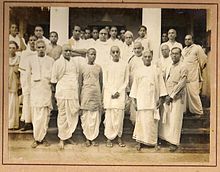
An angavastra (plural, angavastram, Sanskrit: अङ्गवस्त्रम्) is a shoulder cloth or stole worn by men in India, especially in Maharashtra and South India. It is a single, rectangular piece of fabric and may have decorated borders. An angavastra may be worn with a dhoti and kurta. An angavastra may be offered as a mark of respect to guests, elders and gurus.[1]
Style and use[edit]
Angavastra is a simple loose garment, usually paired or matching with dhoti color, draped over the shoulders. It is a traditional wear of South India and a profound fashion statement.
Prime Minister Narendra Modi wore karai veshti dhoti, kurta, and angavastram, the traditional attire during his visit to Arjuna's Penance, Krishna's Butterball, the Pancha Rathas, and Shore Temple.[2][3] A weaver from Varanasi designed and wove a special silk angavastram incorporating Buddhist mantras for Narendra Modi.[4]
References[edit]
- ^ "Rátnagiri and Sávantvádi". Gazetteer of the Bombay Presidency. 10: 112. 1880. Retrieved 10 May 2021.
- ^ "Veshti-Shirt-Angavastram; PM Modi dons the traditional Tamil Nadu outfit for Jinping meet". Zee News. 2019-10-11. Retrieved 2021-01-22.
- ^ "veshti: Latest News & Videos, Photos about veshti | The Economic Times". The Economic Times. Retrieved 2021-01-22.
- ^ "Special 'angavastram' awaits PM Modi in Varanasi". www.daijiworld.com. Retrieved 2021-01-22.
Well, that’s interesting to know that Psilotum nudum are known as whisk ferns. Psilotum nudum is the commoner species of the two. While the P. flaccidum is a rare species and is found in the tropical islands. Both the species are usually epiphytic in habit and grow upon tree ferns. These species may also be terrestrial and grow in humus or in the crevices of the rocks.
View the detailed Guide of Psilotum nudum: Detailed Study Of Psilotum Nudum (Whisk Fern), Classification, Anatomy, Reproduction